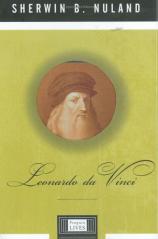Leonardo Da Vinci
Review
Leonardo Da Vinci
![]() It
It
doesn't take much to be a Renaissance Man in this day and age. Do
you know how to change the oil in your car and know the author of
CRIME AND PUNISHMENT? Well, you just might be a Renaissance Man.
Can you make radish roses as well as sand a bookcase? Goodness me,
you're a Renaissance Man! Do you do well on "Jeopardy" and "Wheel
of Fortune?" Heavens to Betsy --- Renaissance Man! There used to be
much more to it than that. Of course, the Renaissance was a revival
of classical art, literature, and learning that originated in Italy
in the 14th century and spread throughout Europe. If you were a
Renaissance Man from back then, you might have been someone like
Leonardo da Vinci. He was a painter, architect, engineer,
philosopher, mathematician, and scientist. Not many so-called
"Renaissance Men" of today could hold a candle to one Mr. da Vinci.
Sherwin B. Nuland takes a look at quite possibly the most famous
man ever to live.Nuland, a Clinical Professor of Surgery at Yale University,
continues the informative and well-received Penguin Lives series
with his short biography. Others in the Penguin Lives series
include Edna O'Brien's look at James Joyce and Mary Gordon's
biography of Joan of Arc. Soon to come include John Keegan on
Winston Churchill, Jane Smiley on Charles Dickens, and Bobbie Ann
Mason on Elvis Presley."The
enigma of the Mona Lisa's smile is not less than the enigma of her
creator's life force." Leonardo da Vinci was born in the Spring of
1452 to a successful notary father and a mother whose personal
information is sparse at best. The facts of the life of Leonardo da
Vinci are sparse as well.A
man with a "near-idolatrous fascination with the life of Leonardo
da Vinci," Nuland uses broad brush strokes in discussing his idol.
"The probings of his mind had gone well beyond the supporting
knowledge and technology of his era. Had much more been available,
it would certainly have released his genius to fly as far in
reality as it did in his conjectures and fantasies."When
da Vinci was young he went into a cave and found a large fossil
fish within it. Nuland then writes, "The significant thing to note
about Leonardo's experience in the cave is that it resulted in a
discovery...centuries before the studies of such as Lyell and
Darwin --- that the earth and its living forms were much older than
was taught by the Church, and are in a continuous state of change."
The question then is, how does Nuland know what young da Vinci was
thinking when he saw the fish?Anatomy takes up a bulk of the short tome, for Nuland is a
surgeon and is interested in such things. But what of da Vinci's
great artistic abilities? "The Last Supper" and the "Mona Lisa?"
What of his engineering feats? What of his interest in mathematics?
These are all touched on, certainly, but with Nuland's focus on
anatomy, much of what da Vinci is most noted for is only glanced
over.I
knew very little of da Vinci the man, and in that regard, LEONARDO
DA VINCI is a good little book for me to have read. His life,
however mysterious and unknowable it is, did come through. Facts
were interspersed with conjecture, his writings were interspersed
with interpretation, and Sherwin Nuland continued his idolatrous
fascination with a man well-ahead of his time.Now,
I have to go out and fix the power mower before I can watch a
documentary on lemurs. That's me, a regular Renaissance
Man.
Reviewed by Jonathan Shipley on January 22, 2011
Leonardo Da Vinci
- Publication Date: October 2, 2000
- Genres: Biography, Nonfiction
- Hardcover: 176 pages
- Publisher: Viking Adult
- ISBN-10: 0670893919
- ISBN-13: 9780670893911




